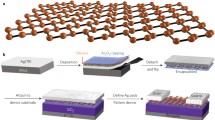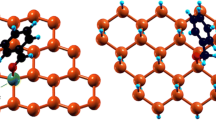Abstract
Applications based on silicene as grown on substrates are of high interest toward actual utilization of this unique material. Here we explore, from first principles, the nature of carbon monoxide adsorption on semiconducting silicene nanoribbons and the resulting quantum conduction modulation with and without silver contacts for sensing applications. We find that quantum conduction is detectably modified by weak chemisorption of a single CO molecule on a pristine silicene nanoribbon. This modification can be attributed to the charge transfer from CO to the silicene nanoribbon and the deformation induced by the CO chemisorption. Moderate binding energies provide an optimal mix of high detectability and recoverability. With Ag contacts attached to a ∼1 nm silicene nanoribbon, the interface states mask the conductance modulations caused by CO adsorption, emphasizing length effects for sensor applications. The effects of atmospheric gases—nitrogen, oxygen, carbon dioxide, and water—as well as CO adsorption density and edge-dangling bond defects, on sensor functionality are also investigated. Our results reveal pristine silicene nanoribbons as a promising new sensing material with single molecule resolution.

Similar content being viewed by others
References
Wang, Y.; Yeow, J. T. W. A review of carbon nanotubes-based gas sensors. J. Sensors 2009, 493904.
Leenaerts, O.; Partoens, B.; Peeters, F. Adsorption of H2O, NH3, CO, NO2, and NO on graphene: A first-principles study. Phys. Rev. B 2008, 77, 125416.
Paulla, K. K.; Farajian, A. A. Concentration effects of carbon oxides on sensing by graphene nanoribbons: Ab initio modeling. J. Phys. Chem. C 2013, 117, 12815–12825.
Ratinac, K. R.; Yang, W.; Ringer, S. P.; Braet, F. Toward ubiquitous environmental gas sensors-capitalizing on the promise of graphene. Environ. Sci. Technol. 2010, 44, 1167–1176.
Schedin, F.; Geim, A. K.; Morozov, S. V.; Hill, E. W.; Blake, P.; Katsnelson, M. I.; Novoselov, K. S. Detection of individual gas molecules adsorbed on graphene. Nat. Mater. 2007, 6, 652–655.
Chung, M. G.; Kim, D. H.; Lee, H. M.; Kim, T.; Choi, J. H.; Seo, D. K.; Yoo, J. B.; Hong, S. H.; Kang, T. J.; Kim, Y. H. Highly sensitive NO2 gas sensor based on ozone treated graphene. Sensor. Actuat. B—Chem. 2012, 166–167, 172–176.
Ao, Z. M.; Yang, J.; Li, S.; Jiang, Q. Enhancement of CO detection in Al doped graphene. Chem. Phys. Lett. 2008, 461, 276–279.
Osborn, T. H.; Farajian, A. A. Stability of lithiated silicene from first principles. J. Phys. Chem. C 2012, 116, 22916–22920.
Osborn, T. H.; Farajian, A. A.; Pupysheva, O. V.; Aga, R. S.; Lew Yan Voon, L. C. Ab initio simulations of silicene hydrogenation. Chem. Phys. Lett. 2011, 511, 101–105.
Gao, N.; Zheng, W. T.; Jiang, Q. Density functional theory calculations for two-dimensional silicene with halogen functionalization. Phys. Chem. Chem. Phys. 2012, 14, 257–261.
Zheng, F.; Zhang, C.; Yan, S.; Li, F. Novel electronic and magnetic properties in N or B doped silicene nanoribbons. J. Mater. Chem. C 2013, 1, 2735–2743.
Léandri, C.; Oughaddou, H.; Aufray, B.; Gay, J. M.; Le Lay, G.; Ranguis, A.; Garreau, Y. Growth of Si nanostructures on Ag(001). Surf. Sci. 2007, 601, 262–267.
Enriquez, H.; Vizzini, S.; Kara, A.; Lalmi, B.; Oughaddou, H. Silicene structures on silver surfaces. J. Phys. Condens. Mat. 2012, 24, 314211.
Le Lay, G.; Aufray, B.; Léandri, C.; Oughaddou, H.; Biberian, J. P.; De Padova, P.; Davila, M. E.; Ealet, B.; Kara, A. Physics and chemistry of silicene nano-ribbons. Appl. Surf. Sci. 2009, 256, 524–529.
Aufray, B.; Kara, A.; Vizzini, S.; Oughaddou, H.; Léandri, C.; Benedicte, E.; Le Lay, G. Graphene-like silicon nanoribbons on Ag(110): A possible formation of silicene. Appl. Phys. Lett. 2010, 96, 183102.
Lian, C.; Ni, J. The structural and electronic properties of silicon nanoribbons on Ag(110): A first principles study. Phys. B Condens. Mat. 2012, 407, 4695–4699.
Perdew, J.; Burke, K.; Ernzerhof, M. Generalized gradient approximation made simple. Phys. Rev. Lett. 1996, 77, 3865–3868.
Ordejón, P.; Artacho, E.; Soler, J. Self-consistent order-N density-functional calculations for very large systems. Phys. Rev. B. Condens. Mat. 1996, 53, R10441–R10444.
Soler, M.; Artacho, E.; Gale, J. D.; Garcia, A.; Junquera, J.; Ordejon, P.; Sanchez-Portal, D. The SIESTA method for ab initio order-N materials simulation. J. Phys. Condens. Mat. 2002, 14, 2745–2779.
Becke, A. D. Density-functional exchange-energy approximation with correct asymptotic behavior. Phys. Rev. A 1988, 38, 3098–3100.
Lee, C.; Hill, C.; Carolina, N. Development of the Colle-Salvetti correlation-energy formula into a functional of the electron density. Phys. Rev. B 1988, 37, 785–789.
Frisch, M. J.; Trucks, G. W.; Schlegel, H. B.; Scuseria, G. E.; Robb, M. A.; Cheeseman, J. R.; Scalmani, G.; Barone, V.; Mennucci, B.; Petersson, G. A., et al. Gaussian 09. (2009).
Farajian, A. A.; Belosludov, R. V.; Mizuseki, H.; Kawazoe, Y. A general-purpose approach for calculating transport in contact-molecule-contact systems: TARABORD implementation and application to a polythiophene-based nanodevice. Thin Solid Films 2006, 499, 269–274.
Sadrzadeh, A.; Farajian, A. A.; Yakobson, B. I. Electron transport of nanotube-based gas sensors: An ab initio study. Appl. Phys. Lett. 2008, 92, 022103.
Dávila, M. E.; Marele, A.; De Padova, P.; Montero, I.; Hennies, F.; Pietzsch, A.; Shariati, M. N.; Gómez-Rodríguez, J. M.; Le Lay, G. Comparative structural and electronic studies of hydrogen interaction with isolated versus ordered silicon nanoribbons grown on Ag(110). Nanotechnology 2012, 23, 385703.
Şahin, H.; Cahangirov, S.; Topsakal, M.; Bekaroglu, E.; Akturk, E.; Senger, R. T.; Ciraci, S. Monolayer honeycomb structures of group-IV elements and III-V binary compounds: First-principles calculations. Phys. Rev. B 2009, 80, 155453.
Lew Yan Voon, L. C.; Sandberg, E.; Aga, R. S.; Farajian, A. A. Hydrogen compounds of group-IV nanosheets. Appl. Phys. Lett. 2010, 97, 163114.
Bacalzo, F. T.; Musaev, D. G.; Lin, M. C. Theoretical studies of CO adsorption on Si(100)-2 × 1 surface. J. Phys. Chem. B 1998, 5647, 2221–2225.
Lian, C.; Yang, Z.; Ni, J. Strain modulated electronic properties of silicon nanoribbons with armchair edges. Chem. Phys. Lett. 2013, 561-562, 77–81.
Luo, L.; Yang, X.; Liang, F.; Jie, J.; Wu, C.; Wang, L.; Yu, Y.; Zhu, Z. Surface dangling bond-mediated molecules doping of germanium nanowires. J. Phys. Chem. C 2011, 115, 24293–24299.
Park, J. S.; Ryu, B.; Moon, C. Y.; Chang, K. J. Defects responsible for the hole gas in Ge/Si core-shell nanowires. Nano Lett. 2010, 10, 116–121.
Luo, L. B.; Yang, X. B.; Liang, F. X.; Xu, H.; Zhao, Y.; Xie, X.; Zhang, W. F.; Lee, S. T. Surface defects-induced p-type conduction of silicon nanowires. J. Phys. Chem. C 2011, 115, 18453–18458.
Hong, K. H.; Kim, J.; Lee, J. H.; Shin, J.; Chung, U. I. Asymmetric doping in silicon nanostructures: The impact of surface dangling bonds. Nano Lett. 2010, 10, 1671–1676.
De Padova, P.; Quaresima, C.; Olivieri, B.; Perfetti, P.; Le Lay, G. Strong resistance of silicene nanoribbons towards oxidation. J. Phys. D. Appl. Phys. 2011, 44, 312001.
Konečný, R.; Doren, D. J. Adsorption of water on Si(100)-(2 × 1): A study with density functional theory. J. Chem. Phys. 1997, 106, 2426–2435.
Qin, C.; Sremaniak, L. S.; Whitten, J. L. CO adsorption on Ag(100) and Ag/MgO(100). J. Phys. Chem. B 2006, 110, 11272–11276.
He, G. Adsorption of Si on Ag(001) from ab initio study. Surf. Sci. 2009, 603, 2021–2029.
Author information
Authors and Affiliations
Corresponding author
Rights and permissions
About this article
Cite this article
Osborn, T.H., Farajian, A.A. Silicene nanoribbons as carbon monoxide nanosensors with molecular resolution. Nano Res. 7, 945–952 (2014). https://doi.org/10.1007/s12274-014-0454-7
Received:
Revised:
Accepted:
Published:
Issue Date:
DOI: https://doi.org/10.1007/s12274-014-0454-7




